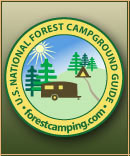Grassland Information
The Curlew National Grassland, comprised of 47,000 acres and
interspersed with private land, is located in southern Idaho on
the Utah northern border. It is administered by the Caribou-Targhee
National Forest. There is one developed campground and it meets
the selection criteria.
The areas now designated as "grasslands" were settled in the
1800s under a variety of "Homestead Acts" that opened the land to
people, generally farmers, and helped to settle the west. A
prolonged period of drought in the late 1920s into the 1930s
caused some homesteads on sub-marginal farmland (a location
receiving 15 or less inches of annual moisture) to literally dry
up and blow away. During this time, Congress established the Land
Utilization Program (LUP) which bought homesteads from bankrupt
private owners and returned it to public land status. The
Civilian Conservation Corps (CCC) helped to stabilize the eroding
soil by re-seeding it and applying other conservation techniques.
In the 1950s, the LUP holdings were assigned to the
USDA Forest Service which was tasked with management of these
sub-marginal lands. Over the years the Forest Service has
established some twenty National Grasslands. "The designation of
the area as National Grassland is not a description of the area
as much as a statement of policy and effort to restore the area
to a multiple of uses and benefits."
The Curlew National Grassland (NG) is a checker board of public and
private land stretching from Snowville, Utah, northward into
Idaho across a wide valley that was once the bottom of the
ancient Bonneville Lake. The Lake is long gone but the shoreline
can still be seen on the hillsides that surround the NG. Long
after the Bonneville Lake disappeared, the People of the Bannock
and Shoshone nations hunted buffalo and deer in the valley. In
1869, with the completion of the transcontinental railroad, the
valley was opened to cattle ranching. Overgrazing and extreme
winter weather halted the growth of big cattle operations in the
valley. By 1889, sagebrush began to dominate the valley floor
and, without the rich, lush native grass, much of the wild game left.
With the cattle operations departure, farmers began to homestead
the area. At one time there was one farm on every 160 acre
parcel of land. Most of the farmers could only manage marginal
success and by the 1930s, between several years of drought, lower
prices for farm goods and the Depression, most of the
homesteaders were near bankruptcy. The Federal government
stepped in and purchased several thousands acres which became the
Curlew NG.
The Forest Service is working to return the Curlew NG to what it
was before the cattle, sagebrush and farmer era while still being a
resource to the local economy. Today, the area's ranchers graze,
under permit, some 21,000 head of cattle on the Grassland. While
it may look arid and desolate, the Forest Service practices help
support a variety of birds and wildlife that provide hunting
opportunities.
Just a few minutes off I-84 and miles away from stress and strain
is the Stone Reservoir with its little Curlew campground. Stone
Reservoir was built more than a hundred years ago by the local
farmers and ranchers to hold water used to irrigate their lands.
It still does today but it also provides a lovely little oasis of
serenity. If you are a bird watcher, a few days in Curlew
campground will be a delight. Canoe enthusiasts will enjoy
exploring the reservoir's irregular shoreline for hidden
surprises and anglers will thrill at the fight in the Largemouth
bass found in the lake.
Interested in history? Take your 4-wheel vehicle out and look
for old homesteads or cemeteries - remember to be respectful of
both. If you find any artifacts, please take only photographs
and report your discovery to the Forest Service.
Don't look for "big" city attractions in the Curlew NG.
Snowville, UT is about the closest thing to that and "groceries"
are found in the Flying-J Truck Stop's convenience store. The
countryside may not have lots of people but it is populated with
good people who enjoy family-focused fun. Examples of this are
the Welsh Festival in Malad City, the July 4th celebration in
Stone and Malad City, both in Idaho, and a couple of area rodeos
held during the summer.
There is a bird called the Curlew and it might live in the Curlew
Grassland. It has a long curved bill which can be one-third the
size of its body. Although classified as a "shore" bird, the
shores this bird inhabits are those on prairies, marshes, and
tidal ponds. It must be a hardy bird to live and survive in an
environment as varied as those mentioned. And that might be the
reason this small NG, stretching across a valley in southern
Idaho, carries its name. The grass, wildlife, and people have to
be hardy to survive and prosper.
The Curlew National Grassland is such a small place. It isn't
well known and receives little notice from people driving between
Salt Lake City to Boise on I-84. However, those who take the
short drive to discover its quiet beauty, remember their time
there.
ADDRESSES
SUPERVISOR ADDRESS
1405 Hollipark Dr
Idaho Falls, Idaho 83401
208-524-7500
RANGER DISTRICT ADDRESSES
Westside
4350 Cliffs Dr.
Pocatello, Idaho 83204
208-236-7500
|
